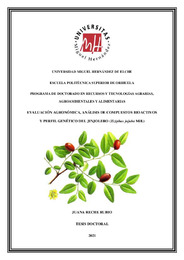Resumen :
Los jínjoles son frutos muy consumidos en China donde, desde la antigüedad, utilizan el fruto, la semilla y la hoja, tanto en alimentación como en medicina, por sus propiedades nutritivas y funcionales, disminuyendo así el riesgo de padecer algunas enfermedades.
Son frutos que varían sus características físico-químicas y funcionales dependiendo del cultivar. Dado que los cultivares españoles no han sido prácticamente estudiados, en esta Tesis Doctoral se evalúan las propiedades físico-químicas de los frutos, piel y pulpa, sus fenoles totales y actividades antioxidantes totales, así como el perfil de ácidos grasos de cinco cultivares españoles cultivados mediante un manejo orgánico y no orgánico. El cultivo del azufaifo en manejo ecológico hace que éstos sean de mejor calidad y más saludables, aunque más pequeños que los cultivados tradicionalmente. También se ha hecho el perfil genético de cinco cultivares por ISSR. Este trabajo permitió diferenciar claramente tres grupos de jínjoles: por un lado, el cultivar ꞌDaꞌ que fue el más diferente y alejado de todos, los cultivares 'Gab' y 'Gam' que fueron cercanos ente sí, y, entre estos dos grupos estarían los cultivares ꞌMeꞌ y ꞌPeꞌ. Finalmente, se ha hecho un estudio de conservación de estos frutos en atmósferas modificadas. Los jínjoles, una vez recolectados y almacenados en MAP, muestran mejores características y una mayor vida útil más del doble de tiempo, que los frutos almacenados sin ninguna película protectora
Jujubes are highly consumed fruits in China where, since ancient times, they use the fruit, the seed and the leaf, both in food and medicine, for their nutritional and functional properties. Thus reducing the risk of suffering from some diseases. They are fruits that vary their physical-chemical and functional characteristics depending on the cultivar., Since Spanish cultivars have not been practically studied, this Doctoral Thesis evaluates the physico-chemical properties of the fruits, peel and pulp, their total phenols and antioxidant activities as well as the fatty acid profile of five Spanish cultivars grown under organic and non-organic management. The cultivation of jujube in ecological management makes them of better quality and healthier, although smaller than those traditionally cultivated. The genetic profile of five cultivars by ISSR has also been done. This work allowed to clearly differentiate three groups of jujube: on the one hand, the cultivar ꞌDaꞌ that was the most different and far from all, the cultivars 'Gab' and 'Gam' that were close to each other, and, between these two groups would be the cultivars ꞌMeꞌ and ꞌPeꞌ. Finally, a conservation study has been made of these fruits in modified atmospheres. The jujube, once collected and stored in MAP, show better characteristics and a longer shelf life more than twice as long as the fruits stored without any protective film
|
 La licencia se describe como: Atribución-NonComercial-NoDerivada 4.0 Internacional.
La licencia se describe como: Atribución-NonComercial-NoDerivada 4.0 Internacional.
.png)
